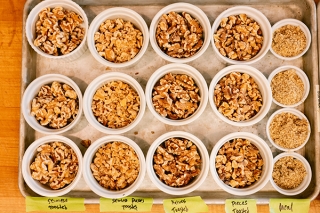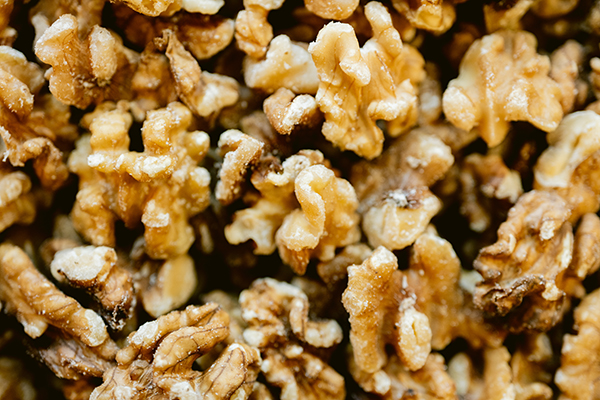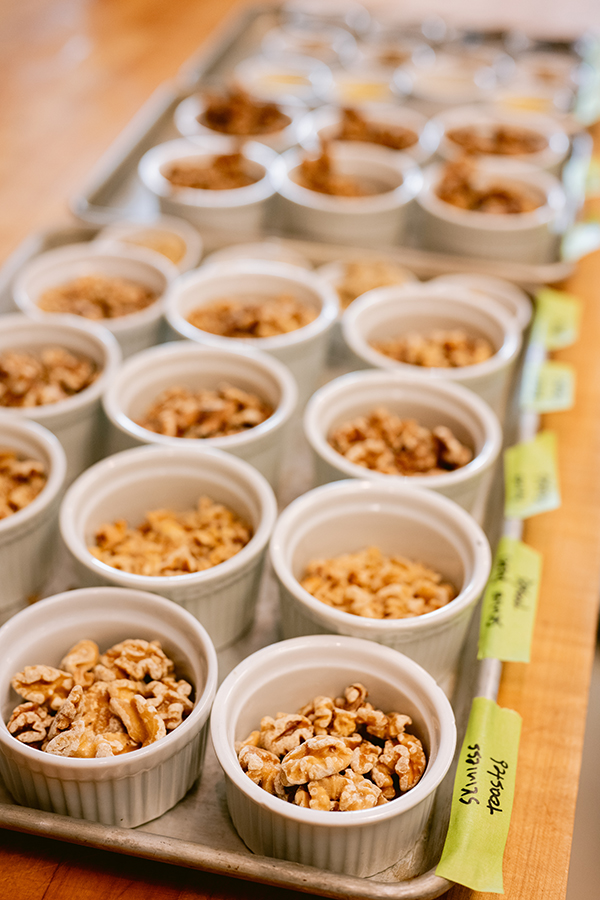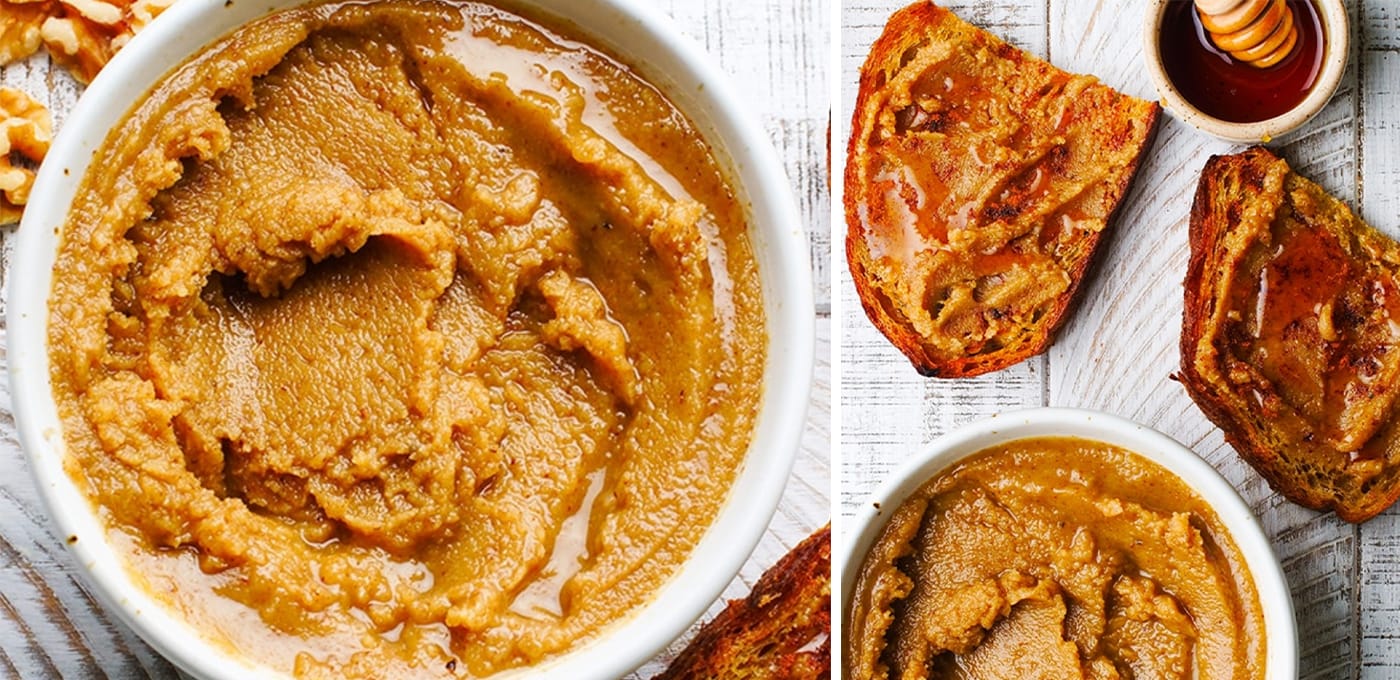
Cracking Open the Culinary Potential of Walnuts: Journey from Orchard to Plate
03 February 2025Read this versatile nut’s story of transformation, creativity and sustainability and find an ingredient that can build a flavor framework of new possibilities.
By California Walnuts
Feedback & comments: This email address is being protected from spambots. You need JavaScript enabled to view it.
 Walnuts are more than just a nut; they are a canvas for culinary innovation. From the orchard to the kitchen, they offer a range of sensory experiences that enhance dishes and broaden flavor profiles. By understanding the journey of walnuts—from raw ingredient to transformed component to final dish—we unlock the secrets of this humble yet versatile food. This exploration, framed within the context of an "ingredient-component-build" approach, opens endless opportunities for chefs and culinary students to experiment, create and discover.
Walnuts are more than just a nut; they are a canvas for culinary innovation. From the orchard to the kitchen, they offer a range of sensory experiences that enhance dishes and broaden flavor profiles. By understanding the journey of walnuts—from raw ingredient to transformed component to final dish—we unlock the secrets of this humble yet versatile food. This exploration, framed within the context of an "ingredient-component-build" approach, opens endless opportunities for chefs and culinary students to experiment, create and discover.
Royal origin
Walnuts are the oldest known tree food known to man, dating back to 7,000 B.C. Walnuts’ origin spans from Central Asia to Southeast Asia’s Himalayas to Eastern Europe. The Romans called English walnuts Juglans regia, “Jupiter’s royal acorn,” with early history indicating that walnuts came from ancient Persia (called “Persian Walnuts”) and were reserved for royalty. Subsequently, they became “English Walnuts” when English merchant marines transported the product for trade to ports around the world. Introduced to California by the Spanish Missionaries in the 1700s, walnuts were mainly planted in Southern California, with the first commercial planting in Santa Barbara County in 1867. By the late 1800s, walnut orchards had grown to 15,000 acres across the state’s southern region, moving most cultivation to the Central Valley, where they are predominantly found today with 370,000 acres in production by 4,600 walnut growers.
Exploring layers of flavor
From the moment a walnut is harvested, its qualities begin to take shape. The initial characteristics of the walnut kernel—its color, texture and even the sound it makes when bitten—are all important factors in determining its culinary applications.
A fresh walnut has a crisp texture, and as you bite into it, the smooth release of fats transforms the texture, adding a creamy feel. Its nutty flavor profile can include a sweet, bitter and umami experience. The aromatic attributes of walnuts are experienced through both ortho-nasal perception, which occurs during inhalation through the nose, and retro-nasal perception, which occurs during chewing and exhalation, allowing the release of volatile compounds for a fuller flavor experience. To explore the 360-degree walnut sensory experience, reference the Walnut Flavor Wheel.
A game-changing innovation in the walnut world is the development of skinless walnuts. Removing the slightly bitter outer pellicle results in a much milder flavor and lighter color, making them suitable for delicate sauces, dips and desserts. This innovation not only enhances the walnut’s flavor but also broadens its culinary possibilities.
Traditionally, walnuts have been seen as a simple ingredient—a raw, shelled nut that can be tossed into salads or baked into cakes. But when viewed through the lens of innovation, walnuts are transformed into versatile ingredients and components that elevate a dish, building complexity of textures and flavors throughout.
Driving the ingredient-component-build model
As ingredients, walnuts are available in multiple forms—whole in-shell, halves, pieces, medium pieces, small pieces, meal and flour—each suited to specific culinary applications. Recipe-ready chopped walnuts, granules, meals, flours and powders open avenues for product development. For instance, walnut oil production yields a protein-rich press cake that can be milled into fine powders that could fortify doughs, improve textures or serve as thickeners. Prepared “walnut meat” products offer plant-based opportunities to leverage trending walnut innovations, aligning with and meeting the growing consumer demand for sustainable proteins in both the foodservice and retail sectors.
Moving toward component development, raw walnut kernels are transformed from an unadorned ingredient into a more processed walnut component, such as seasoned walnut butter or a walnut-based plant protein blend, gaining layered sensory meaning. Roasting, blending with spices or sweeteners, or processing to transform into walnut meat, flour, creams or butters excites the senses and culinary creativity to enable cooks, chefs and product developers to create foods and beverages that deliver on trending, sophisticated expectations.
Imagine how you might incorporate these innovative components to introduce unexpected variations on common options:
- Walnut Butter: By grinding walnuts into a smooth paste, we create a base that can be used in both sweet and savory applications. The addition of spices or sweeteners can turn walnut butter into a component that serves as a filling for chocolates or a spread for bread.
- Walnut Cream: Made from blending walnuts with water, walnut creams can range from a thin, dairy-free milk alternative to a thick, rich spread, perfect for sauces, dressings or even as a filling for pastries.
- Walnut Flour: Finely milled walnuts can be incorporated into baked goods, adding a subtle nutty flavor and improving moisture retention. Walnut flour can also serve as a gluten-free alternative, where it also deepens the dough's flavor profile.
The true magic happens when walnut components are layered and integrated into a build—the final dish that brings all the elements together—highlighting their strengths and enhancing the overall flavor profile.
Take, for example, an empanada:
- The dough incorporates walnut flour, giving it a subtle nutty note and increasing the nutritional content.
- The filling uses chopped walnuts, spiced and cooked with tomatoes and peppers, adding texture and depth.
- A cilantro-lime walnut cream dip serves as a rich, flavorful accompaniment that complements the savory empanada.
Each walnut component—whether in the dough, filling, or sauce—enhances the dish, creating a unified flavor experience that highlights its multisensory potential.
Journey full circle
As culinary professionals, we also have the responsibility to consider the health of our patrons and the planet. Fortunately, walnuts deliver on both counts.
In a recent announcement from the FDA, walnuts were determined to meet the updated definition of a healthy food. Walnuts are the only tree nut recognized as an excellent source of omega-3 ALA (2.5g/oz), an essential fatty acid with the potential to support heart health and cognition. One ounce of walnuts contains 13 grams of polyunsaturated and 2.5 grams of monounsaturated fat. With their versatility across the culinary landscape, walnuts can play an important role in following more nutritious dietary patterns, including reducing the intake of saturated fat by substituting ingredients containing unsaturated fats as advised by the 2025 Dietary Guidelines Advisory Committee Scientific Report.
The utilization of the entire walnut is an important part of the industry’s sustainability efforts. The shell can be ground up and used in cosmetics; as an abrasive; in water filtration; in plastics; as fillers; in pet applications; and even as an energy source. When feasible, hulls removed at harvest time are returned to the orchard soil. During winter pruning, the branches that are removed are chipped or shredded and distributed across the orchard to decompose, increasing soil health, tilth, and water-holding capacity.
Looking ahead
The journey of walnuts from orchard to plate is a story of transformation, creativity, and sustainability. By viewing walnuts through the lens of the ingredient-component-build framework, culinary professionals can unlock new possibilities for this versatile nut.
Try this tasting exercise with your students
Click here for five slides describing the 360-degree flavor experience of California walnuts.
Distribute four or five walnut halves and pieces to students. Begin with slide one: California Walnut Flavor Wheel. Discuss how sight unveils walnuts’ unique characteristics and their use as components and builds. Slide two highlights the external gnarly shape, which holds walnuts in place in recipes like scones. Move to texture in slide three and place a walnut half between molars, bite slowly, and observe its progression—crispy to mealy, to creamy to tooth packing. Finally, explore tastes in slide four: sweet, savory, slightly salty, sour and umami. Encourage students to reflect on walnuts’ sensory evolution.
